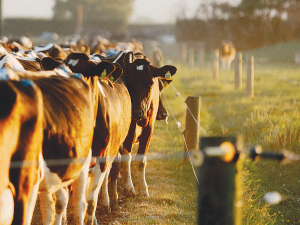Dairy sector profit still on the table, but margin gap tightens
DairyNZ’s latest Econ Tracker update shows most farms will still finish the season in a positive position, although the gap has narrowed compared with early season expectations.
 Despite a challenging 2021-22 season, the dairy sector appears to have responded well during a challenging time.
Despite a challenging 2021-22 season, the dairy sector appears to have responded well during a challenging time.
Despite a challenging 2021-22 season, the annual New Zealand Dairy Statistics report shows an innovative dairy sector responding well during a changeable time.
Released last week by DairyNZ and Livestock Improvement Corporation, the report shows that in the 2021-22 season, 20.78 billion litres of milk containing 1.87 billion kgMS was processed by dairy companies.
After reaching a record milk production per herd and per cow in the previous 2020/21 season, production dropped back to 2019/20 levels as the impacts of Covid-19, climatic conditions on farm, inflationary pressures and supply chain issues presented a challenging year for the industry.
The trend of declining cow and herd numbers continued and was accompanied by a 4.3% decrease in litres and 4.1% decrease in kilograms of milksolids processed, compared to the previous season.
DairyNZ chief executive Dr Tim Mackle acknowledges that farmers' achievements in the face of a range of challenges in recent years is positive.
"Through tough times farmers continue to prove their resilience and stay focused on milking better and more efficient cows, by making the most of technology and information," says Mackle.
"Dairy farmers are proud to be world leading and work hard to retain their unique pasture-based farm system, as they keep milk production flowing and therefore creating real value for New Zealanders."
The season saw an increased uptake of herd improvement services, with record herd testing levels of 3.79 million cows. Artificial insemination remained steady at 3.94 million cows.
This continues the trend of New Zealand farmers remaining focused on improving the production efficiency of their herds, and utilising data and insights to support on-farm decisions.
LIC chief executive David Chin says New Zealand farmers responded well to the challenges of the 2021-22 season.
"Rising to challenges in a changing world is nothing new for our sector. Our farmers continue to invest in solutions that will support them to remain global dairy sector leaders.
"Record levels of herd testing uptake and strong investment in artificial breeding demonstrates a continued focus from farmers on herd improvement, to identify poor performing cows and to breed more efficient animals."
The average dairy co-operative payout from Fonterra and Tatua was $9.52/kgMS, which was a record average payout for farmers, while dairy exports reached a record $22 billion in 2021/22.
Key Statistics
The National Wild Goat Hunting Competition has removed 33,418 wild goats over the past three years.
New Zealand needs a new healthcare model to address rising rates of obesity in rural communities, with the current system leaving many patients unable to access effective treatment or long-term support, warn GPs.
Southland farmers are being urged to put safety first, following a spike in tip offs about risky handling of wind-damaged trees
Third-generation Ashburton dairy farmers TJ and Mark Stewart are no strangers to adapting and evolving.
When American retail giant Cosco came to audit Open Country Dairy’s new butter plant at the Waharoa site and give the green light to supply their American stores, they allowed themselves a week for the exercise.
Fonterra chair Peter McBride says the divestment of Mainland Group is their last significant asset sale and signals the end of structural changes.
President Donald Trump’s decision to impose tariffs on imports into the US is doing good things for global trade, according…
Seen a giant cheese roll rolling along Southland’s roads?